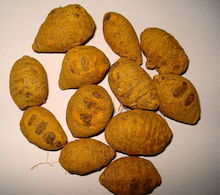What Are the Benefits of Turmeric and Curcumin?
HEALTH, 6 Jun 2016
Dr Edward Group, Global Healing Center – TRANSCEND Media Service
 Turmeric has been traditionally used for pulmonary and gastrointestinal system problems. Research within the 50 years has shown much of the supposed benefit of turmeric is due to curcumin, the active component. Curcumin, a polyphenol, has displayed activity in antioxidant, anti-redness, anti-harmful organism capacities. Because of this, polyphenols have generated inquiries into their potential to provide support for ailments proven to be therapy resistant, including chronic illnesses. Although curcumin is used as a supplement in many countries, it has not been approved for the treatment of any human disease. Regardless, the experimental research and animal studies have many people interested in the benefits of this golden spice. [1] [2]
Turmeric has been traditionally used for pulmonary and gastrointestinal system problems. Research within the 50 years has shown much of the supposed benefit of turmeric is due to curcumin, the active component. Curcumin, a polyphenol, has displayed activity in antioxidant, anti-redness, anti-harmful organism capacities. Because of this, polyphenols have generated inquiries into their potential to provide support for ailments proven to be therapy resistant, including chronic illnesses. Although curcumin is used as a supplement in many countries, it has not been approved for the treatment of any human disease. Regardless, the experimental research and animal studies have many people interested in the benefits of this golden spice. [1] [2]
How Does Turmeric Work?
Oxidative stress reactions are critical stressors in the body that predicate many chronic illnesses. Curcumin has been thought to have beneficial effects against chronic illnesses due to its potent anti-oxidant activities. [3] [4] Oxidative damage causes aging, stress on cells and oxidative damage can result from free radicals. Oxidative damage is a huge concern in cases of obesity, liver disease, and alcohol induced liver problems. In fact, Researchers at China’s Tongji Medical College discovered curcumin may potentially offer improvement for chronic alcoholic liver disease due to it’s propensity to alleviate oxidative damage. [5]
Curcumin, capsaicin, and gingerol, have been reported to provide improved health to their consumers, especially with regard to diabetes. Research by the Department of Pathology at Saint Louis University discovered that curcumin inhibits the effects of insulin on fat storage cell activation by interrupting insulin signaling and reducing oxidative stress. [6]
Obesity leads to many problems, including liver disease. In a study designed to examine the effect of curcumin on liver irritation, researchers at National Yang Ming University discovered that obese mice, when given curcumin, lost weight and had reduced cholesterol levels. Researchers noted the results offered encouragement that curcumin may have potential for confronting fatty liver disease. [7] This action is due to curcumin’s inhibition of fat storage cell activity, the major instigators of liver disease. In cultured fat storage cells, curcumin was found to suppress bad cholesterol and inhibit fat storage cell activation. [8]
Efficacy against Harmful Organisms
In research intended to examine the activity of curcumin against food pathogens, including e. coli, the College of Food Science and Technology in China evaluated curcumin’s effect on cultured organisms and found it to have broad inhibitory effect. Furthermore, researchers noted its resistance to fungus to be even higher. [9]
In a study aimed to evaluate the inhibitory effect of curcumin on harmful organisms, human teeth that had been inoculated were found to have reduced bacterial adherence after being given curcumin. Results support the use of curcumin as a food-based agent that fights harmful organisms. [10]
Recent Developments
Although many preclinical studies suggest curcumin has therapeutic application, the effectiveness of curcumin in randomized, placebo-controlled, double-blind clinical trials is still to come. Some have speculated the bioavailability of curcumin to be sub par and that may limit its application. Now, some studies have responded by formulating curcumin nano particles to determine if the decreased particle size increases bioavailability. One study involving rats and asthma found that curcumin nanoparticles increased concentrations of curcumin in the lung and liver; the nano-particles effectively suppressed airway hyperresponsiveness and irritation, leading to conclusions that curcumin nano particles could eventually be a promising candidate for asthma therapy. [11] [12] [13]
Supplementing with Turmeric
There are a lot of turmeric supplements on the market so there’s no excuse for not getting one that’s high quality.
References:
- Gupta SC, Patchva S, Koh W, Aggarwal BB. Discovery of curcumin, a component of golden spice, and its miraculous biological activities. Clin Exp Pharmacol Physiol. 2012 Mar;39(3):283-99. doi: 10.1111/j.1440-1681.2011.05648.x. Review.
- Bengmark S, Mesa MD, Gil A. Plant-derived health: the effects of turmeric and curcuminoids. Nutr Hosp. 2009 May-Jun;24(3):273-81. Review.
- Boonjaraspinyo S, Boonmars T, Aromdee C, Srisawangwong T, Kaewsamut B, Pinlaor S, Yongvanit P, Puapairoj A. Turmeric reduces inflammatory cells in hamster opisthorchiasis. Parasitol Res. 2009 Oct;105(5):1459-63. doi: 10.1007/s00436-009-1553-3. Epub 2009 Jul 25.
- Noorafshan A, Ashkani-Esfahani S. A review of therapeutic effects of curcumin. Curr Pharm Des. 2013;19(11):2032-46.
- Rong S, Zhao Y, Bao W, Xiao X, Wang D, Nussler AK, Yan H, Yao P, Liu L. Curcumin prevents chronic alcohol-induced liver disease involving decreasing ROS generation and enhancing antioxidative capacity. Phytomedicine. 2012 Apr 15;19(6):545-50. doi: 10.1016/j.phymed.2011.12.006. Epub 2012 Mar 23.
- Lin J, Zheng S, Chen A. Curcumin attenuates the effects of insulin on stimulating hepatic stellate cell activation by interrupting insulin signaling and attenuating oxidative stress. Lab Invest. 2009 Dec;89(12):1397-409. doi: 10.1038/labinvest.2009.115. Epub 2009 Oct 19.
- Kuo JJ, Chang HH, Tsai TH, Lee TY. Positive effect of curcumin on inflammation and mitochondrial dysfunction in obese mice with liver steatosis. Int J Mol Med. 2012 Sep;30(3):673-9. doi: 10.3892/ijmm.2012.1049. Epub 2012 Jun 29.
- Kang Q, Chen A. Curcumin inhibits srebp-2 expression in activated hepatic stellate cells in vitro by reducing the activity of specificity protein-1. Endocrinology. 2009 Dec;150(12):5384-94. doi: 10.1210/en.2009-0517. Epub 2009 Oct 6.
- Wang Y, Lu Z, Wu H, Lv F. Study on the antibiotic activity of microcapsule curcumin against foodborne pathogens. Int J Food Microbiol. 2009 Nov 30;136(1):71-4. doi: 10.1016/j.ijfoodmicro.2009.09.001. Epub 2009 Sep 8.
- Song J, Choi B, Jin EJ, Yoon Y, Choi KH. Curcumin suppresses Streptococcus mutans adherence to human tooth surfaces and extracellular matrix proteins. Eur J Clin Microbiol Infect Dis. 2012 Jul;31(7):1347-52. doi: 10.1007/s10096-011-1448-y. Epub 2011 Oct 19.
- Gupta SC, Patchva S, Aggarwal BB. Therapeutic roles of curcumin: lessons learned from clinical trials. AAPS J. 2013 Jan;15(1):195-218. doi: 10.1208/s12248-012-9432-8. Epub 2012 Nov 10.
- Pasqualetti P, Colantonio D, Casale R, Di Lauro G, Collacciani A, Festuccia V, Trotta A, Natali G. [Prognostic evaluation in multiple myeloma. Relationship between immunological types, single prognostic factors, clinical staging systems, morphological classification systems and survival]. Ann Ital Med Int. 1990 Jul-Sep;5(3 Pt 1):195-204. Italian.
- Bhawana, Basniwal RK, Buttar HS, Jain VK, Jain N. Curcumin nanoparticles: preparation, characterization, and antimicrobial study. J Agric Food Chem. 2011 Mar 9;59(5):2056-61. doi: 10.1021/jf104402t. Epub 2011 Feb 15.
_____________________________________
Dr Edward Group III DC, NP, DACBN, DCBCN, DABFM has studied natural healing methods for over 20 years and now teaches individuals and practitioners all around the world. He no longer sees patients but solely concentrates on spreading the word of health and wellness to the global community. Under his leadership, Global Healing Center, Inc. has earned recognition as one of the largest alternative, natural and organic health resources on the Internet.
Go to Original – globalhealingcenter.com
DISCLAIMER: The statements, views and opinions expressed in pieces republished here are solely those of the authors and do not necessarily represent those of TMS. In accordance with title 17 U.S.C. section 107, this material is distributed without profit to those who have expressed a prior interest in receiving the included information for research and educational purposes. TMS has no affiliation whatsoever with the originator of this article nor is TMS endorsed or sponsored by the originator. “GO TO ORIGINAL” links are provided as a convenience to our readers and allow for verification of authenticity. However, as originating pages are often updated by their originating host sites, the versions posted may not match the versions our readers view when clicking the “GO TO ORIGINAL” links. This site contains copyrighted material the use of which has not always been specifically authorized by the copyright owner. We are making such material available in our efforts to advance understanding of environmental, political, human rights, economic, democracy, scientific, and social justice issues, etc. We believe this constitutes a ‘fair use’ of any such copyrighted material as provided for in section 107 of the US Copyright Law. In accordance with Title 17 U.S.C. Section 107, the material on this site is distributed without profit to those who have expressed a prior interest in receiving the included information for research and educational purposes. For more information go to: http://www.law.cornell.edu/uscode/17/107.shtml. If you wish to use copyrighted material from this site for purposes of your own that go beyond ‘fair use’, you must obtain permission from the copyright owner.

Turmeric has been a real blessing in my life. If you’re interested in natural medicine you should definitely check out the ebook “10 super herbs that will change your life forever”. You can download it for free here: tensuperherbs.com. That book helped me so much